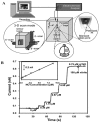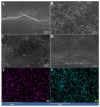Design and Electrochemical Study of Platinum-Based Nanomaterials for Sensitive Detection of Nitric Oxide in Biomedical Applications
- PMID: 28335341
- PMCID: PMC5245754
- DOI: 10.3390/nano6110211
Design and Electrochemical Study of Platinum-Based Nanomaterials for Sensitive Detection of Nitric Oxide in Biomedical Applications
Abstract
The extensive physiological and regulatory roles of nitric oxide (NO) have spurred the development of NO sensors, which are of critical importance in neuroscience and various medical applications. The development of electrochemical NO sensors is of significant importance, and has garnered a tremendous amount of attention due to their high sensitivity and selectivity, rapid response, low cost, miniaturization, and the possibility of real-time monitoring. Nanostructured platinum (Pt)-based materials have attracted considerable interest regarding their use in the design of electrochemical sensors for the detection of NO, due to their unique properties and the potential for new and innovative applications. This review focuses primarily on advances and insights into the utilization of nanostructured Pt-based electrode materials, such as nanoporous Pt, Pt and PtAu nanoparticles, PtAu nanoparticle/reduced graphene oxide (rGO), and PtW nanoparticle/rGO-ionic liquid (IL) nanocomposites, for the detection of NO. The design, fabrication, characterization, and integration of electrochemical NO sensing performance, selectivity, and durability are addressed. The attractive electrochemical properties of Pt-based nanomaterials have great potential for increasing the competitiveness of these new sensors and open up new opportunities in the creation of novel NO-sensing technologies for biological and medical applications.
Keywords: biomedical applications; electrocatalysis; electrochemical sensors; modified electrodes; nanomaterials; nitric oxide; platinum; tungsten.
Conflict of interest statement
The authors declare no conflict of interest.
Figures









Similar articles
-
Carbon Nanomaterials Based Electrochemical Sensors/Biosensors for the Sensitive Detection of Pharmaceutical and Biological Compounds.Sensors (Basel). 2015 Sep 4;15(9):22490-508. doi: 10.3390/s150922490. Sensors (Basel). 2015. PMID: 26404304 Free PMC article.
-
Graphene-family materials in electrochemical aptasensors.Anal Bioanal Chem. 2021 Jan;413(3):673-699. doi: 10.1007/s00216-020-02915-y. Epub 2020 Sep 17. Anal Bioanal Chem. 2021. PMID: 32939567 Review.
-
Facile Synthesis of Platinum Nanoparticle-Embedded Reduced Graphene Oxide for the Detection of Carbendazim.Materials (Basel). 2023 Dec 13;16(24):7622. doi: 10.3390/ma16247622. Materials (Basel). 2023. PMID: 38138764 Free PMC article.
-
In-situ synthesis of Pt nanoparticles/reduced graphene oxide/cellulose nanohybrid for nonenzymatic glucose sensing.Carbohydr Polym. 2023 Mar 1;303:120463. doi: 10.1016/j.carbpol.2022.120463. Epub 2022 Dec 17. Carbohydr Polym. 2023. PMID: 36657845
-
Electrochemical sensor and biosensor platforms based on advanced nanomaterials for biological and biomedical applications.Biosens Bioelectron. 2018 Apr 30;103:113-129. doi: 10.1016/j.bios.2017.12.031. Epub 2017 Dec 22. Biosens Bioelectron. 2018. PMID: 29289816 Review.
Cited by
-
Amperometric Microsensors Monitoring Glutamate-Evoked In Situ Responses of Nitric Oxide and Carbon Monoxide from Live Human Neuroblastoma Cells.Sensors (Basel). 2017 Jul 19;17(7):1661. doi: 10.3390/s17071661. Sensors (Basel). 2017. PMID: 28753952 Free PMC article.
-
A flexible and physically transient electrochemical sensor for real-time wireless nitric oxide monitoring.Nat Commun. 2020 Jun 25;11(1):3207. doi: 10.1038/s41467-020-17008-8. Nat Commun. 2020. PMID: 32587309 Free PMC article.
-
Graphene nanocomposites for real-time electrochemical sensing of nitric oxide in biological systems.Appl Phys Rev. 2023 Nov 30;10:041310. doi: 10.1063/5.0162640. Appl Phys Rev. 2023. PMID: 38229764 Free PMC article.
References
-
- Eroglu E., Gottschalk B., Charoensin S., Blass S., Bischof H., Rost R., Madreiter-Sokolowski C.T., Pelzmann B., Bernhart E., Sattler W., et al. Development of Novel FP-Based Probes for Live-Cell Imaging of Nitric Oxide Dynamics. Nat. Commun. 2016;7:10623. doi: 10.1038/ncomms10623. - DOI - PMC - PubMed
-
- Yong Y., Li C., Li X., Li T., Cui H., Lv S. Ag7Au6 Cluster as a Potential Gas Sensor for CO, HCN, and NO Detection. J. Phys. Chem. C. 2015;119:7534–7540. doi: 10.1021/acs.jpcc.5b02151. - DOI
Publication types
LinkOut - more resources
Full Text Sources
Other Literature Sources

